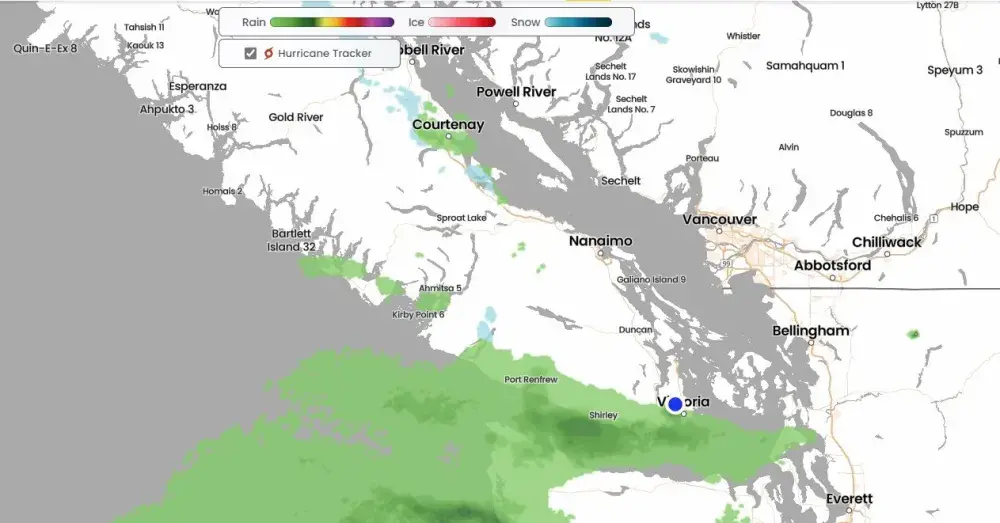Residents in Port Alberni woke up to a light dusting of wet snow on the morning of Nov. 19. Other than the weather forecasts, there was no hint that a freight train of a storm is set to hit coastal British Columbia in a few hours.
The Ministry of Emergency Management and Climate Readiness issued a bulletin advising residents to prepare for stormy weather that is expected to continue through to Wednesday, Nov. 20.
Environment and Climate Change Canada has issued wind warnings and special weather statements due to a significant fall storm that will bring southeasterly winds through the afternoon on Tuesday, with peak wind speeds expected that evening for most coastal regions.
Meteorologists are calling the storm a ‘bomb cyclone’ and for those living near the ocean, the warnings are being taken seriously. They are preparing for the worst.
The massive storm is circulating over the north Pacific Ocean and is quickly picking up strength. When its back edge hits coastal British Columbia and the US states of Alaska, Washington and Oregon later today it is expected to be packing hurricane-force winds with gusts of 90 – 110 kilometres an hour along with a deluge of rain.
The storm is expected to cause damage including fallen trees, flooding, land slides and heavy snow at higher elevations.
According to Curtis Dick of Ahousaht’s Emergency Response Team, the remote island nation has been preparing for the storm. Their Emergency Response Team are gathering information from credible sources and are working in partnership with many Ahousaht departments to prepare for this storm.
“We’re reminding people to tidy up their yards and hunker down,” he said, referring to the danger of wind picking up and tossing things like trampolines and other debris.
Aware that this storm is packing hurricane-force winds, Dick is concerned that the term ‘bomb cyclone’ may be causing more fear.
“Social media is helpful to get information, and we are doing our best to notify everyone, but you have to get your information from a credible source,” he said.
Rumours are circulating that there will be 70-foot waves offshore from this storm, but that Dick says that hasn’t been confirmed by Environment Canada or other official weather sources.
Ahousaht emergency response workers have arranged transportation via Ahousaht Fisheries for residents making emergency supply runs to Tofino a day ahead of the storm so that they can get fuel, food and other supplies to be prepared in the event of an extended power outage.
In Hot Springs Cove, Hesquiaht Chief Councillor Mariah Charleson says residents there are encouraged to get their emergency kits ready.
“Men will be keeping a close eye on the boats and the dock. The school will be closed tomorrow in case anyone needs to go to the school for any given reason – it will be open for members through the duration of the storm,” she told Ha-Shilth-Sa.
The school in Hot Springs Cove is built high on a hill and was designed to serve as an emergency evacuation/sheltering center for residents of the isolated community.
“Ahousaht has reached out and given us their plan and contacts as they met with emergency management via coordination call,” said Charleson.
Ahousaht has issued emergency contact information for its residents. It reminded people that, in the event of an emergency, there will be no access to the hospital or any other emergency care outside of the village. Storm conditions will make travel out of the community impossible. To attempt to leave the village by boat for an emergency would risk the lives of not only the patient, but also the emergency first responders and boat operators.
An emergency shelter is being set up for residents living in homes that may not be able to withstand the storm. Ahousaht childcare workers have set out small cots for children and have sofas and space for air mattresses at their facility.
Cermaq Canada operates salmon farms in Ahousaht territory and have staff living on the floating systems during their shifts. Liz Crum, Cermaq’s communications specialist, says they’ve seen these types of storms in the past and have learned from them.
“We batten down the hatches and begin moving loose objects to safe places,” said Crum.
She said the company’s staff have been aware of the approaching storm since the weekend and have been preparing accordingly.
Each site, said Crum, is fully stocked with safety equipment, first aid supplies, food, fuel and water, which is all a part of Cermaq’s Operational Safety Plan.
“We prepare for things like tsunamis and earthquakes,” said Crum.
Crews are keeping a close eye on the weather and tides and managers decide when it is time for crews to head inside to shelter from the storm.
Ahead of storms, Cermaq staff step up their safety checks of equipment.
“They usually check things three to four times daily, but when a storm is coming, they triple and even quadruple their safety checks to keep staff, equipment and fish safe,” Crum said.
The province had deployed resources in preparation for the storm. The Ministry of Transportation and Transit will have maintenance contractors monitoring conditions, clearing culverts and pre-positioning crews and equipment to respond quickly to potential flooding or debris buildup during this weather event, to ensure safe and clear roadways.
The Ministry of Emergency Management and Climate Readiness is able to issue broadcast intrusive alerts as requested by First Nations and local governments to warn people in areas where there may be imminent threats due to flooding.
The province reminds residents to be prepared. Put together emergency kits that include food, water and supplies that will support your household for a week.
In the event of flooding, steer clear of river and coastal shorelines. Do not drive through flood waters, cautions provincial agencies. Do not go out on the water, as storm surges can generate strong currents.
Extensive water pooling on roads can be expected. Never attempt to drive or walk in flood water. Approximately 15 centimetres (six inches) of fast-moving water can knock over an adult, and 61 centimetres (two feet) of rushing water can carry away most vehicles, including SUVs and pickup trucks.
Check Environment and Climate Change Canada for up-to-date forecasts and alerts: http://www.weather.gc.ca


